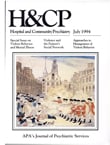Assaults by Patients on Psychiatric Residents at Three Training Sites
Abstract
This study attempted to determine bow often psychiatric residents are exposed to violence, the types of violence they encounter, and what institutional changes might increase their safety. Methods: Safety conditions at two private general hospitals and one state hospital that served as training sites for a psychiatric residency program were assessed through a survey of psychiatric residents and site visits to the hospitals. The survey asked residents to quantify violent incidents occurring in the emergency rooms, wards, and clinics at each site. The site visits focused on safety issues related to staff training, physical layout, staffing patterns, current policies, and compliance with policies. Results: All 47 residents in the training program responded to the survey. None reported serious injuiy, although as many as 56 percent had been physically assaulted on the wards of one hospital, and 54 percent of residents had encountered a weapon in one emergency room. Almost all residents had been verbally threatened or had witnessed violence to others. A paradoxical finding of the survey was that the residents felt safest in the hospital that had the highest rate of violence. The site visits revealed that deficiencies in the safety procedures were allowing weapons to be brought into patient care areas. Conclusions: Psychiatric residents are often exposed to dangerous situations, although serious injury is rare. Residents' beliefs about their level of safety seem to be influenced more by how competent they perceive the staffto be than by the frequency of violence. The findings from the site visits pointed to two steps to increase safety: creating a weapon-free environment by searching all patients and finding ways to improve compliance with existing safety measures.
Access content
To read the fulltext, please use one of the options below to sign in or purchase access.- Personal login
- Institutional Login
- Sign in via OpenAthens
- Register for access
-
Please login/register if you wish to pair your device and check access availability.
Not a subscriber?
PsychiatryOnline subscription options offer access to the DSM-5 library, books, journals, CME, and patient resources. This all-in-one virtual library provides psychiatrists and mental health professionals with key resources for diagnosis, treatment, research, and professional development.
Need more help? PsychiatryOnline Customer Service may be reached by emailing [email protected] or by calling 800-368-5777 (in the U.S.) or 703-907-7322 (outside the U.S.).



